Melrose, Scottish Borders
Melrose (Scottish Gaelic: Maolros, "bald moor")[1] is a small town and civil parish in the Scottish Borders, historically in Roxburghshire.[2] It lies within the Eildon committee area of Borders Regional Council.
Melrose
| |
|---|---|
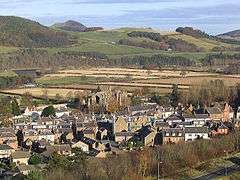 | |
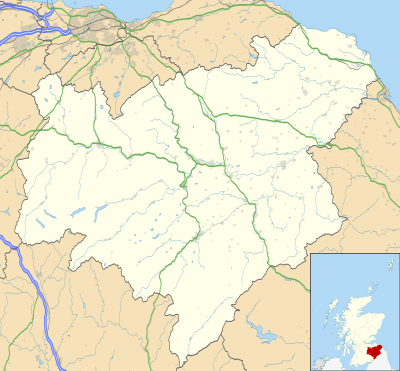 Melrose Location within the Scottish Borders | |
| Population | 1,671 (2001) |
| OS grid reference | NT5434 |
| Council area | |
| Lieutenancy area | |
| Country | Scotland |
| Sovereign state | United Kingdom |
| Post town | MELROSE |
| Postcode district | TD6 |
| Dialling code | 01896 |
| Police | Scotland |
| Fire | Scottish |
| Ambulance | Scottish |
| UK Parliament | |
| Scottish Parliament | |
History
The original Melrose was Mailros, meaning "the bare peninsula" in Old Welsh or Brythonic. This referred to a neck of land by the River Tweed several miles east of the present town, where in the 6th century a monastery was founded associated with St Cuthbert. It was recorded by Bede, and also in the Anglo-Saxon Chronicle with the name Magilros. This monastery and settlement, later known as "Old Melrose", were long abandoned by the 12th century.
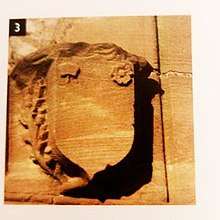
King David I of Scotland took the throne in 1124, and sought to create a new Cistercian monastery on that site; however the monks preferred a site further west called "Fordel". So the monastery now known as Melrose Abbey was founded there in 1136, and the town of Melrose grew up on its present site around it. In the late Middle Ages, its name was represented by a mell (a mason's hammer) and a rose (for the Virgin Mary, to whom all Cistercian abbeys were dedicated). The Abbey fell into ruin after the Reformation but is still a striking structure. Several Scottish nobles are buried there, and a casket has been found which is believed to contain the heart of King Robert the Bruce. The casket has been re-buried in the Abbey. The Abbey ruins are cared for by Historic Scotland (open all year; entrance charge).
Nearby is the Roman fort of Trimontium, Abbotsford House the home of Sir Walter Scott, and Dryburgh Abbey where he's buried. Melrose is surrounded by the small villages of Darnick, Gattonside, Newstead, Lilliesleaf and Bowden.
The Melrose war memorial was designed by Sir Robert Lorimer in 1920.[3]
Sport
Melrose is the birthplace of Rugby Sevens and also has a rugby union team, Melrose RFC. Every year on the second Saturday in April the famous Melrose Sevens are held at the Greenyards and is the biggest annual sporting event held in the town. Rugby union has always been the most popular sport in Melrose.
Melrose Golf Club is a nine-hole golf course situated on the edge of the town at the foot of the Eildon Hills.
Melrose Cricket Club is situated next to Borders General Hospital at Huntlyburn.
Festivals
Every June, the week-long Melrose Festival takes place. This involves appointing a Melrosian who has lived in the town for most of his life; and a queen and her court are appointed from the local primary school, Melrose Primary School (previously named Melrose Grammar School).
Melrose is now host to the annual Borders Book Festival[4] which also takes place during June. The 2005 festival hosted guests including Michael Palin and Germaine Greer; Ian Rankin and Rory Bremner appeared in 2006.
Other events
Melrose hosts the annual Eildon Two Hills Race, attracting many runners, and the Melrose Pipe Band Championships, attracting pipers from all over the world.
Notable people
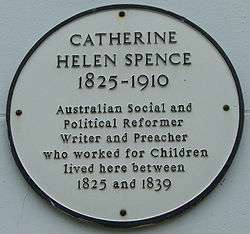
- King Arthur, supposedly buried in the Eildon Hills, which overlook the town
- James Blair, recipient of the Victoria Cross
- Craig Chalmers, rugby union footballer, capped 60 times for Scotland
- Sir Adam Ferguson, army officer and Deputy Keeper of the Scottish Regalia lived at Huntlyburn House, now a wing of the Hospital.
- Ned Haig, butcher and rugby union footballer who founded rugby sevens and the Melrose Sevens
- John Robertson Henderson FRSE FZS FLS, zoologist
- William Kerr, recipient of the Victoria Cross
- Keith Robertson, rugby union footballer
- Mark Robertson, son of Keith Robertson; rugby union sevens, 2016 Olympic silver medalist
- Sir Walter Scott, his home Abbotsford House lies a few miles west of the town
- Catherine Helen Spence (1825–1910), Australian author, teacher, journalist, politician and suffragette; born in Melrose, and left for Australia aged fourteen
- Jim Telfer, rugby union footballer and coach
Gallery
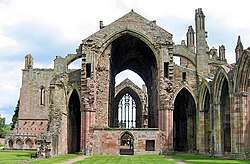 Melrose Abbey
Melrose Abbey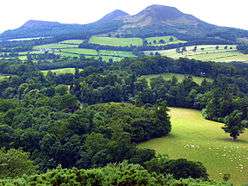 Eildon Hills
Eildon Hills Abbotsford
Abbotsford Market Square
Market Square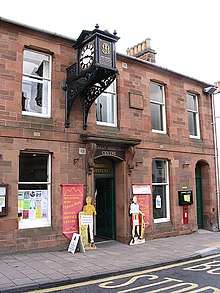 The Roman Heritage Centre
The Roman Heritage Centre
See also
References
- "Gaelic Placenames collected by Iain Mac an Tailleir (2003)" (PDF). Scottish.parliament.uk. Retrieved 2 March 2019.
- "Database: Melrose". Gaelic Place-names of Scotland. Ainmean-Àite na h-Alba. Archived from the original on 27 March 2016. Retrieved 31 October 2011.
- Dictionary of Scottish Architects: Robert Lorimer
- "Borders Book Festival". Borders Book Festival. Retrieved 2 March 2019.
External links
| Wikimedia Commons has media related to Melrose, Scottish Borders. |